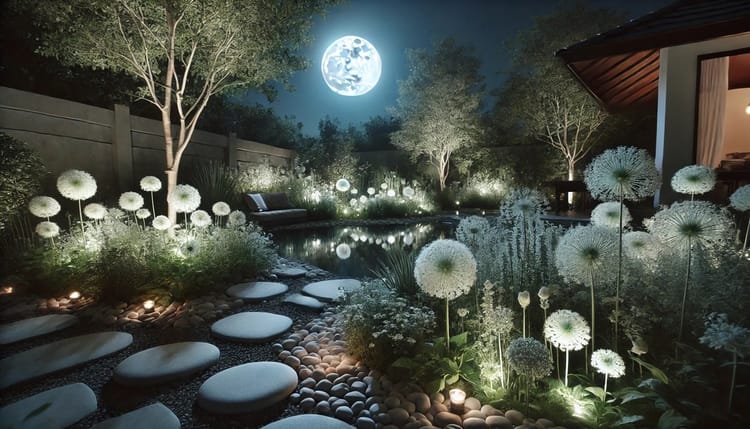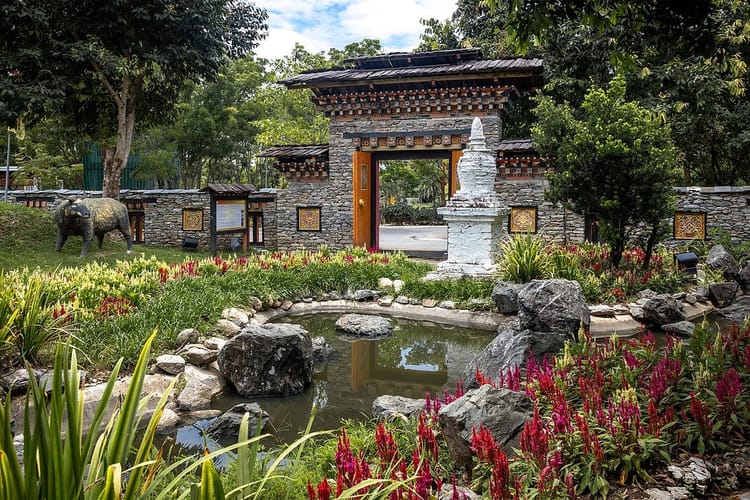Dark Plants Add Drama to your Garden

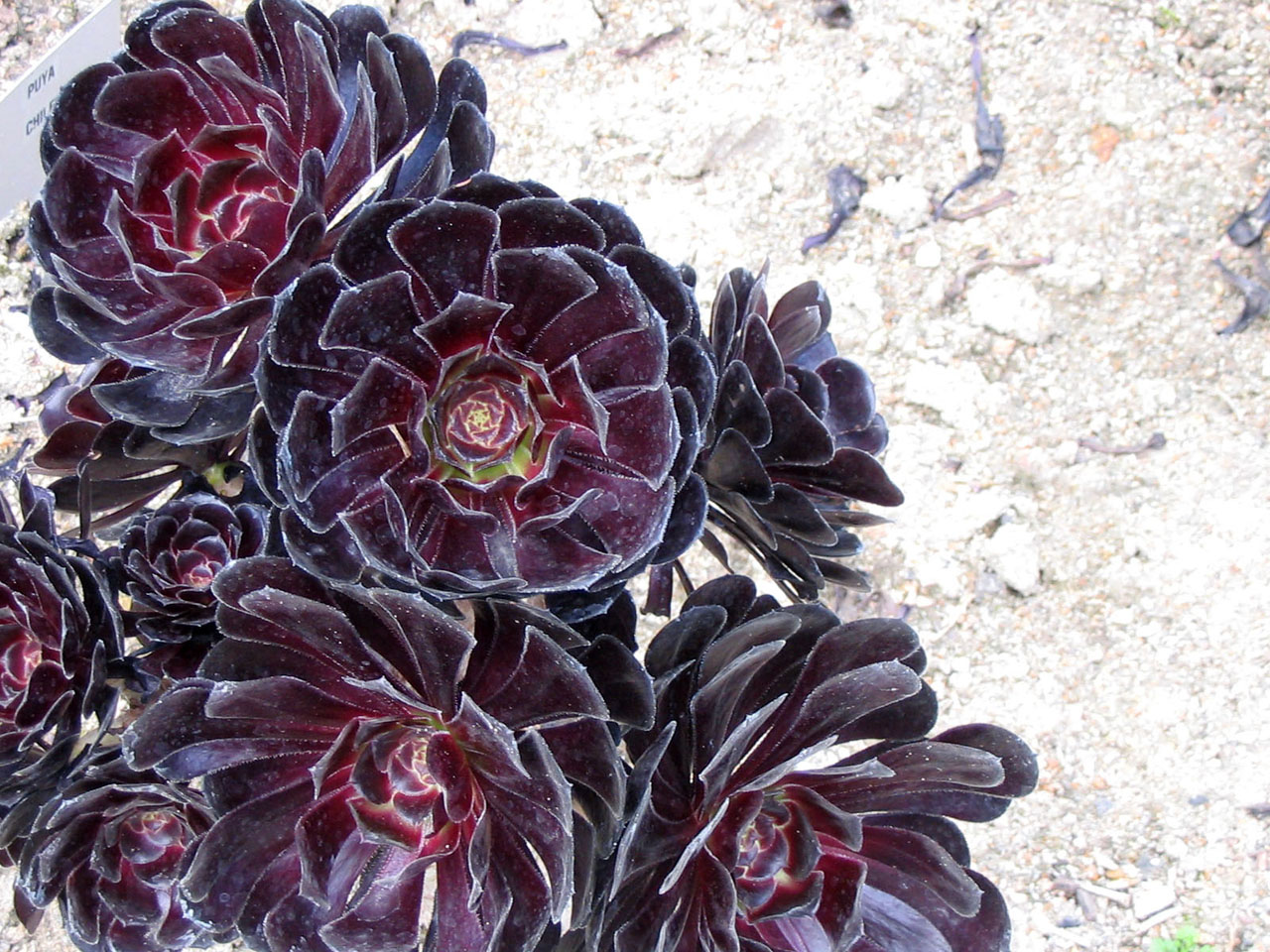
Dark leaved or flowering plants can create a dramatic effect in your garden. These types of plants become big talking points to garden visitors as most people have not seen many plants with dark foliage or flowers.
Dark plants are not very common and create visual drama due to their unexpected presence in a world that is dominated by different shades of green. Carefully placed plants with dark foliage or flowers can create a very dramatic look due to the contrast with the more common colors in a garden. Although black is considered to be a neutral color in fashion or interior design, it is not something that should be overused in the garden, unless that is a specific theme you are looking for. The only style of garden where a multitude of dark plants should be used is in the modern Goth Garden. Used sparingly, dark colored plants work very well in Contemporary, Cottage or Tropical landscapes. If you are planning on adding dark plants to your garden design, a few key principles should be followed:
1. Dark colors are better in sun than in shade. While plants with dark colors tend to blend into dimly lit areas, they take on a captivating brilliance under direct sunlight. While dark colored plants can appear to be black in dim light, under the sun you can often see that they are dark shades of purple or burgundy that take on a different look when reflecting bright light, with many giving off a silvery shimmer.
2. Dark colors work best with light colors. Amplifying the contrast between darkness and lightness enhances the allure of dark flowers and foliage. Lime green and silver prove to be especially potent companions for dark plants, along with white or cream tones, as well as delicate pastels like pale yellow, lavender, or soft pink.
3. Dark plants should be illuminated for nighttime viewing. It likely comes as no surprise that darker colored plants can get lost in the darkness, just like they do when situated in shady areas. In a similar fashion to being out in the sun, the colors are enhanced when light is reflected revealing a richer color than what would appear to be a neutral black hue without any light. Using landscape lighting to shine on the leaves of dark foliage plants will add a different feel to your garden when viewed at night. Dark Trees or large shrubs with an open canopy can create stunning silhouette forms when illuminated against a wall.
4. Dark plants work best as focal points. Dark plants are not very common and create visual drama due to their unexpected presence in a world that is generally dominated by different shades of green. Carefully placed plants with dark foliage or flowers can create a very dramatic look due to the contrast with the more common colors in a garden. Although black is considered to be a neutral color in fashion or interior design, it is not something that should be overused in the garden.
Here are some of the dark colored plants I have worked with on my garden projects:
Small Shrubs and Groundcovers
Aeonium arboreum 'zwartkopf'
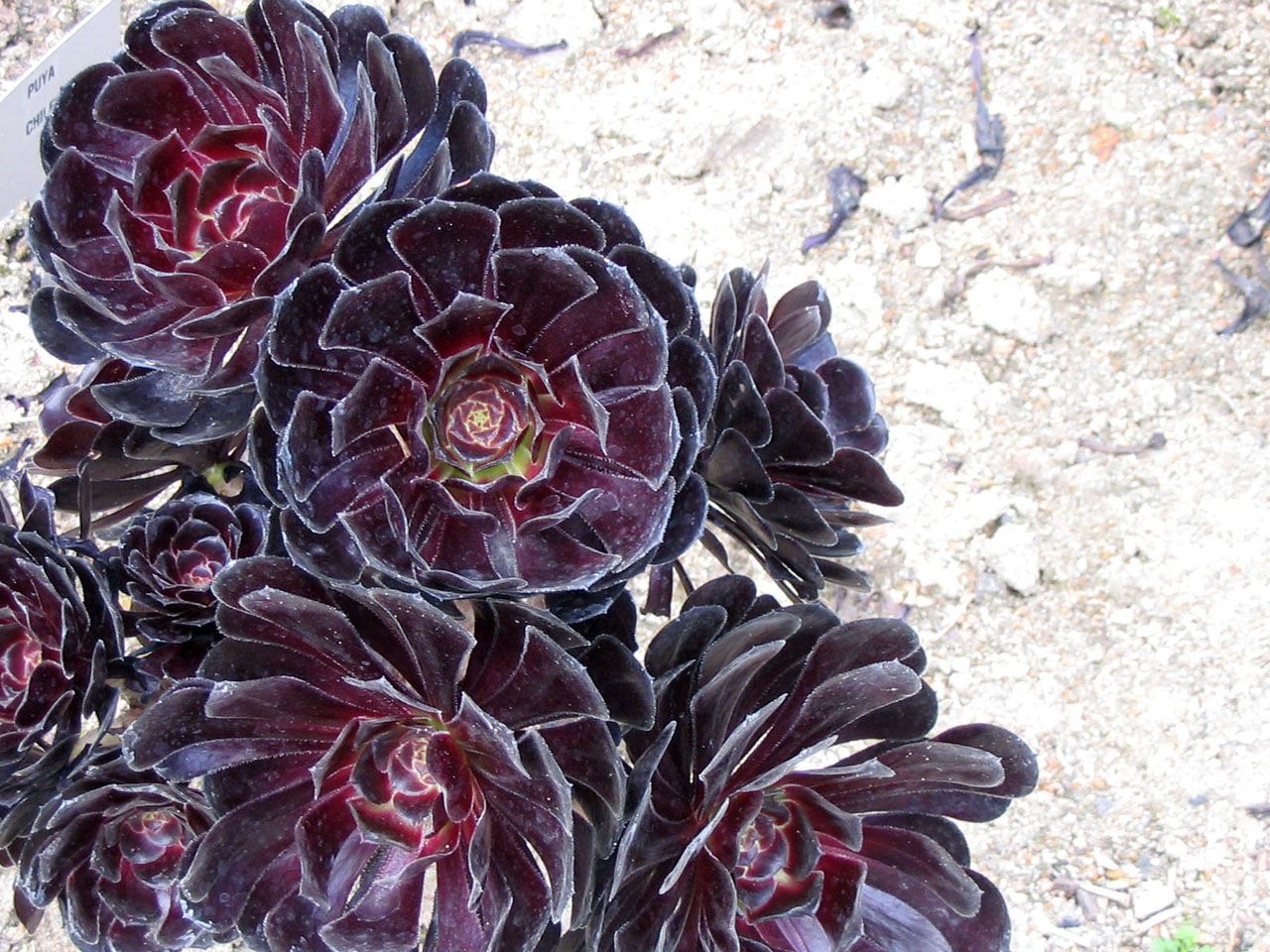
Sometimes described as Black Rose, this is a succulent that can grow as big as a medium-sized shrub with a rosette formed by very dark purple leaves. When grown in a full sun location, the foliage will appear almost completely black and a mix of purple and green when grown in part shade. If you want the dramatic contrast against other blue or green colored succulents, this needs to be in a full sun location. Aeoniums work well in contemporary and Mediterranean gardens, and is an excellent choice as a low maintenance potted plant.
Aeonium arboreum 'zwartkopf' is hardy to USDA zones 9-11. In colder climates, this is best planted in pots which can be brought indoors during Winter.
Japanese barberry (Berberis thunbergii f. atropurpurea)
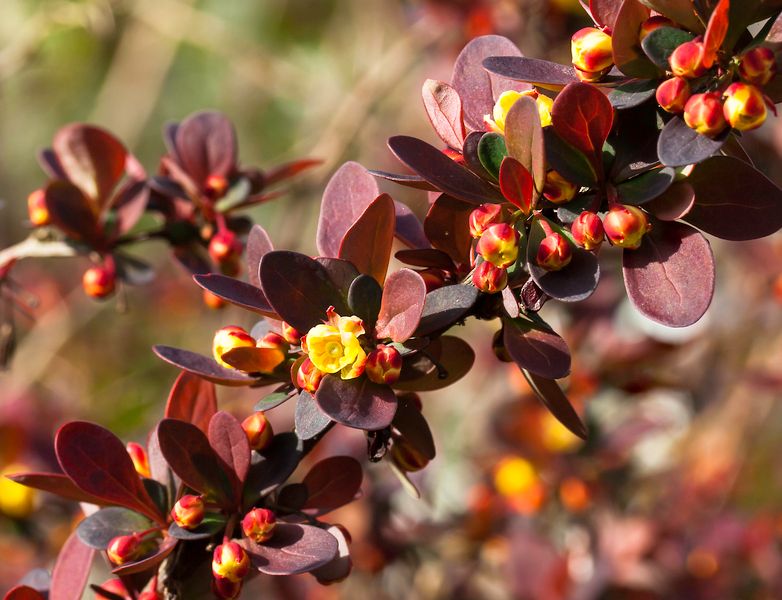
There are a number of Japanese barberry cultivars that give us a lot of choice in different colored leaves. Cultivars with a botanical name ending in atropurpurea have dark purple leaves that can appear almost black but will change color in Autumn to a more deep red tone. As such this isn't a year round dark plant, however it does provide some fall color variation unlike the other small shrubs in this list.
Berberis thunbergii f. atropurpurea is hardy to USDA zones 4-9.
Black Hollyhock (Alcea rosea nigra)
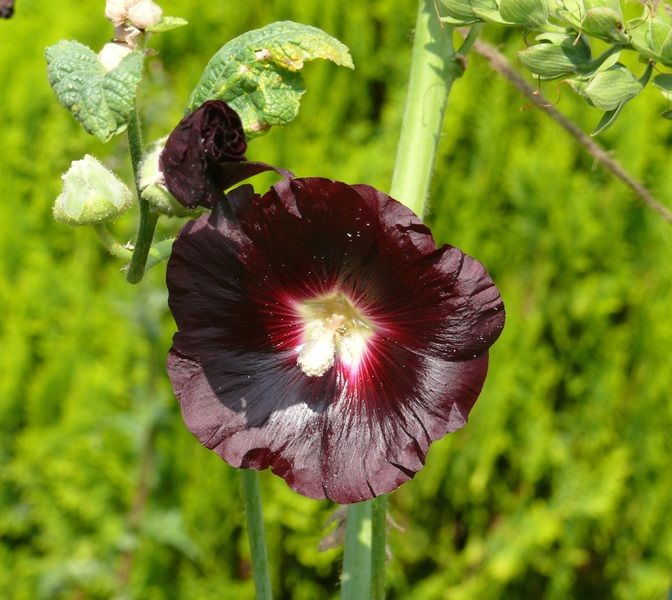
Black Hollyhock is unlike the other plants here in that it doesn't have dark leaves, instead it has dark, almost black flowers. Hollyhocks grow as narrow tall stems, and work best placed at the back of mixed perennial bed in a cottage garden. The black flowering hollyhocks look best when there is a lighter background and in a position where the evening sun can shine on the flowers to reveal the deep purple hues.
Alcea rosea is hardy to USDA zones 4-10.
Purple Sweet Potato Vine (Ipomoea batatas 'Purple' )
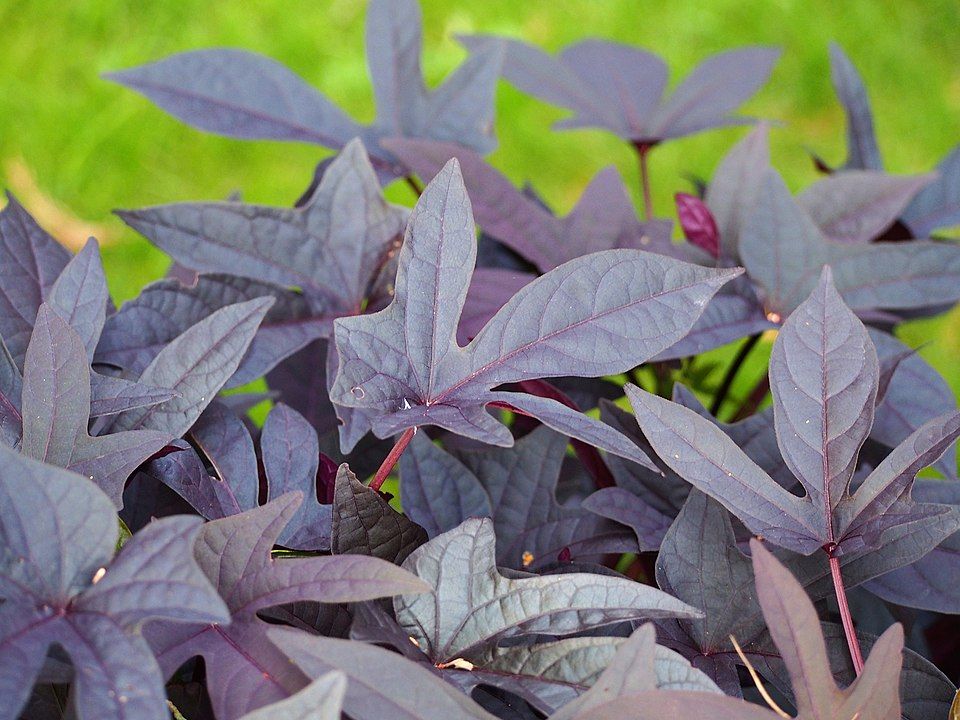
Purple Sweet Potato vine is an ornamental version of the plant that Sweet Potatoes are grown from. This is the only vine on this list and is the only vine I am familiar with that has persistently dark leaves. The dark purple leaves appear very dark but there is enough color to provide some texture in its appearance. Works well as a sprawling ground cover, or grown spilling out of containers. Several varieties of Ipomoea batatas have dark leaves, however I find the 'purple' and 'Blackie' varieties to be the the most visually interesting due to the shape of the leaves. This is a tropical plant and is best suited for cottage or tropical gardens in humid climates, it does not do well in arid climates.
Ipomoea batata is hardy to USDA zones 9-11. In cooler climates they can be grown as annuals, or they can be dug up and stored in winter as tender bulbs for replanting in Spring.
Black Mondo Grass (Ophiopogon planiscapus 'nigrescens')
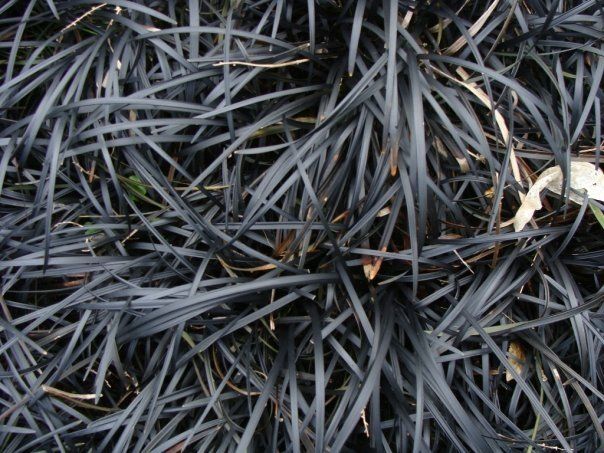
Black Mondo Grass is a useful drought tolerant ground cover for the edges of garden beds in a contemporary garden, or scattered around a rock garden. The leaves of this plant are actually a very dark green that is only apparent when the sun is shining directly on it, and will look almost pitch black in the shade.
Ophiopogon planiscapus 'nigrescens' is hardy to USDA zones 5-10.
Volcanic Sorrel (Oxalis spiralis vulcanicola)
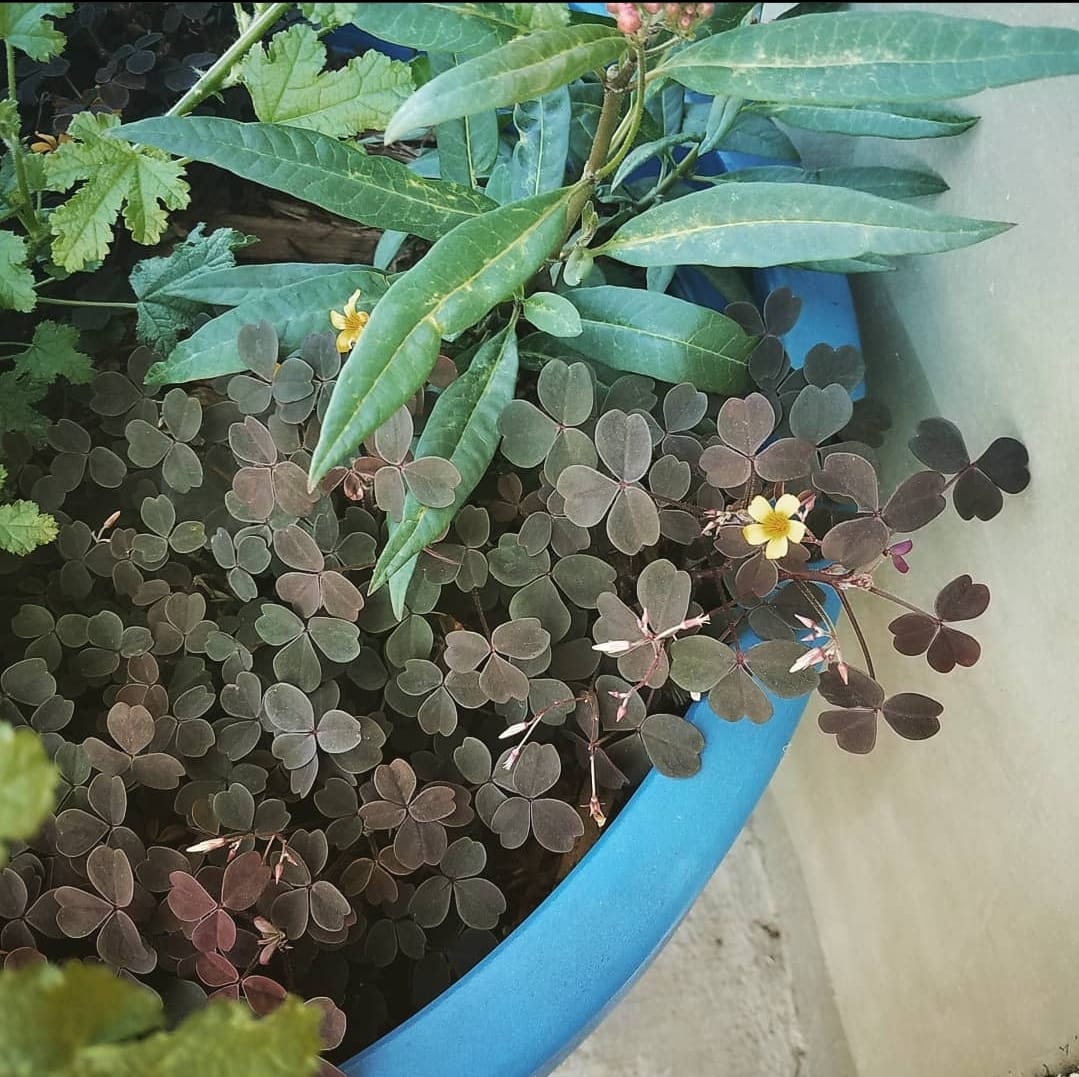
Volcanic Sorrel has leaves very similar to clover and is very useful as a filler in container plants. The 'Zinfandel' and 'Molten Lava' varieties both have very dark burgundy leaves that appear almost black in low light but will present a reddish hue in full sun. Small yellow flowers appear from Spring to Autumn, contrasting strongly against the dark foliage.
Oxalis spiralis vulcanicola is hardy to USDA zones 9-11 but can be treated as an annual in colder regions.
Heuchera
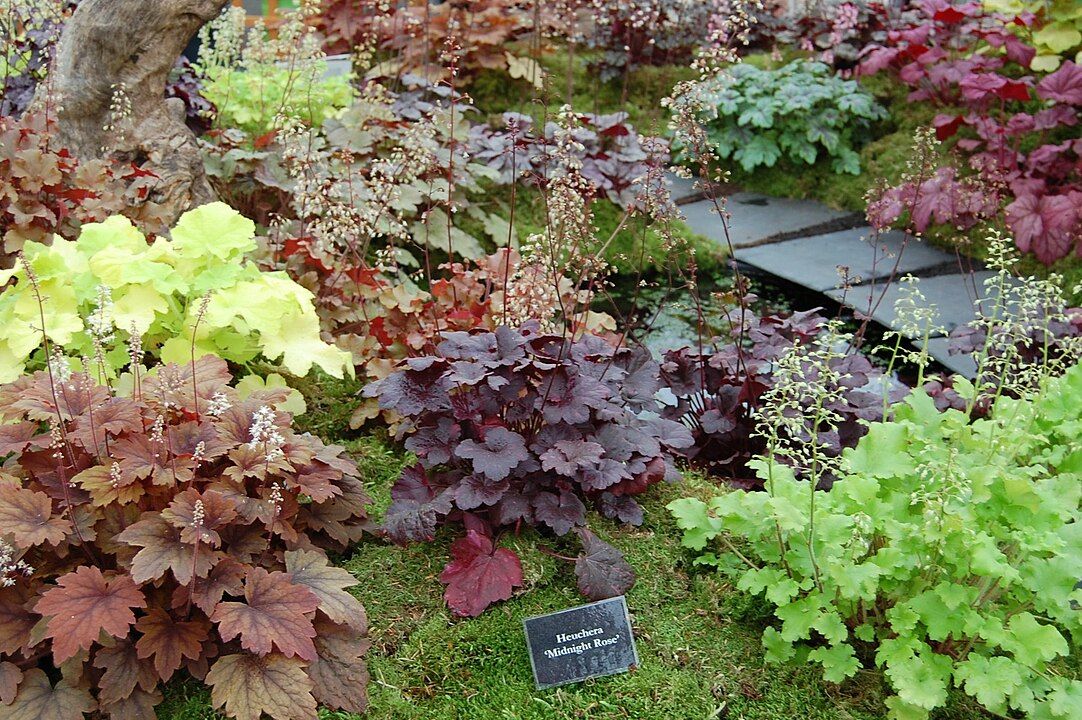
Several varieties of Heuchera, commonly known as "Coral Bells", are available with dark foliage. As you can see in the picture above, a mixed planting of Heuchera cultivars can show a range of colors when the dark varieties are intermixed with lighter varieties. I find that the delicate flowers of Heuchera are much more showy with the dark leaved versions providing a lot of contrast to the white or pink flowers. Common dark leaved varieties include "Midinght Sun", "Chocolate Ruffles", "Obsidian", "Mocha" and "Starry Night". Once established, Heuchera is generally easy to maintain but may need extra water in sunny spots.
Heuchera is hardy to USDA zones 4-9.
Dahlia

Dahlias comprise a large group of flowering herbaceous perennials that are available in over 57,000 different cultivars for use in the garden. There are a large number of Dahlias with bronze colored foliage that is so dark it appears black. Dahlias are mostly grown for their flowers which can bloom all Summer long and into Autumn. Dahlias make excellent cut flowers and removing flowers will encourage more blooming. With Dark colored leaves, in addition to the dramatic contrast with green leaved companions in the garden, they also provide a strong contrast with the flowers making them a real eye-catcher. Dark leaved Dahlias are best planted sparsely in mixed perennial beds and they work well with informal or cottage style gardens.
Dahlias are hardy to USDA zones 8-11. In cooler climates they can be grown as annuals, or they can be dug up and stored in winter as tender bulbs for replanting in Spring.
Large Shrubs and Trees
Ceanothus 'Tuxedo'
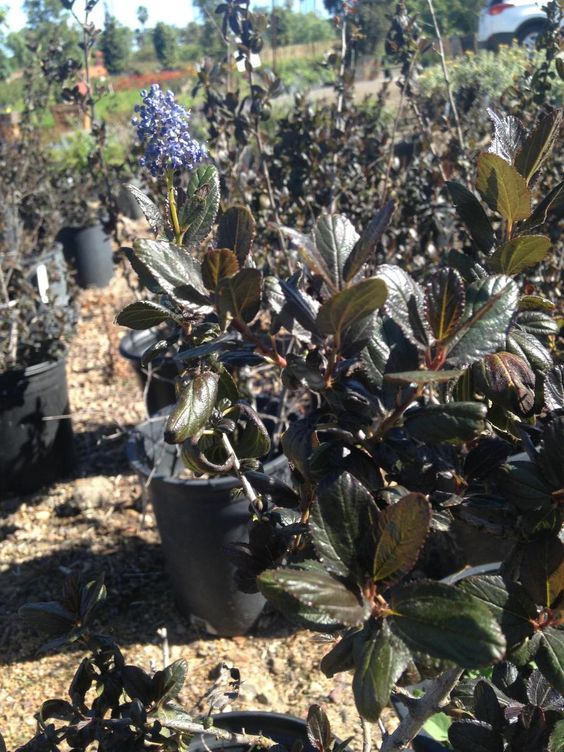
Ceanothus 'Tuxedo' is a California Lilac selection, which was cultivated by Fitzgerald nursery in Ireland. It was cultivated with cuttings from a Ceanothus 'Autumnal Blue' which has mixed lineage of both California Lilacs as well as cold-hardy Ceanothus from the East Coast of the US. This means that the plant is still fairly drought tolerant but able to handle colder weather and does not mind summer water, making it very suitable for use in temperate gardens, as well as a Mediterranean climate. The leaves on this Ceanothus are almost completely black and have a glossy texture. This Ceanothus flowers later than most, and is a good companion for a mixed planting with a lighter colored Ceanothus such as C. Thysiflorus 'Zanzibar' to create a continuous show of blue blossoms from Spring to Autmun.
Ceanothus 'Tuxedo' is hardy to USDA zones 8-11. It can be prone to powdery mildew so it needs good airflow and full sun.
Purpleleaf Plum (Prunus ceracifera 'Nigra')
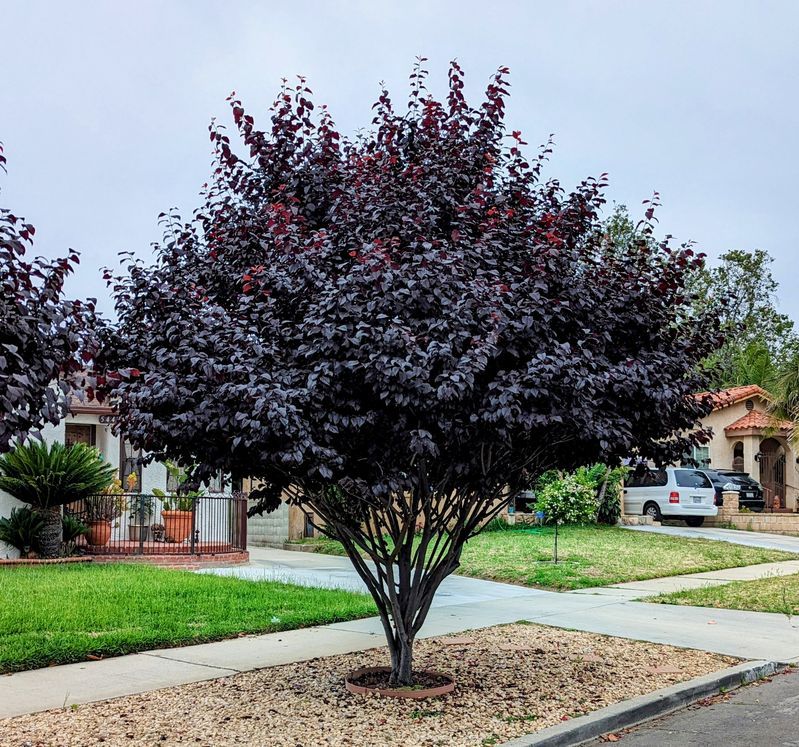
Purpleleaf Plum is probably the most common dark-leaved plant, as it is commonly used as a suburban street tree. It has deep purple leaves that appear almost completely black in mid-summer. This is a deciduous tree so you will not get the year round effect of the dark leaves but it does have dark wood so maintains a dark appearance even when dormant. Pink flowers cover the tree in Spring before new leaves start to appear. This tree is well-suited to a Japanese garden, or as a specimen tree in a more traditional landscape.
Prunus ceracifera is hardy to USDA zones 4-9.
Black Lace Elderberry (Sambucus nigra 'Black Lace')
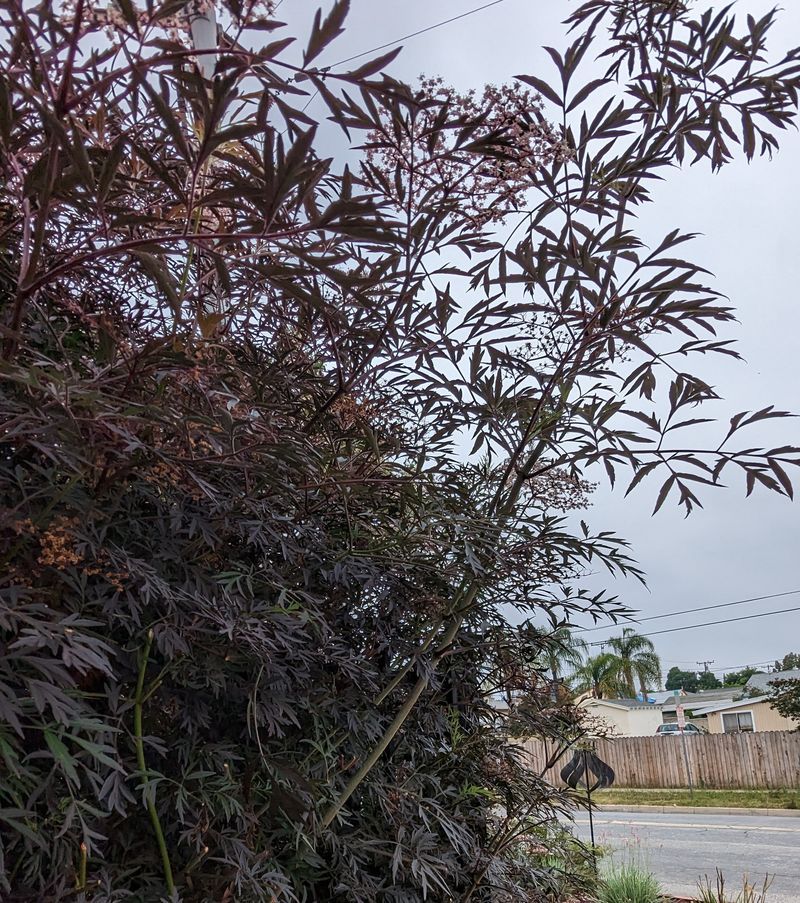
Black Lace is a form of Elderberry that does not grow as large as the straight species and is more like a large shrub than a tree. It also differs from standard Elderberry with its deep purple foliage that darkens to almost pitch black when placed in full sun. The white flowers that appear in umbels in early Summer are accentuated with the contrast they provide to the dark leaves. The leaves are thin and this shrub looks really good when planted so that it's canopy mixes with nearby lighter colored shrubs. Similar to the purpleleaf plum tree, this is deciduous and will only sport the dark foliage from Spring to Autumn. As with other elderberry plants, this produces edible berries in late summer which attracts birds and makes this a great candidate for a wildlife garden.
Sambucus nigra 'Black Lace' is hardy to USDA zones 5-8.
Purple Smoke Tree (Cotinus coggygria 'Royal Purple')
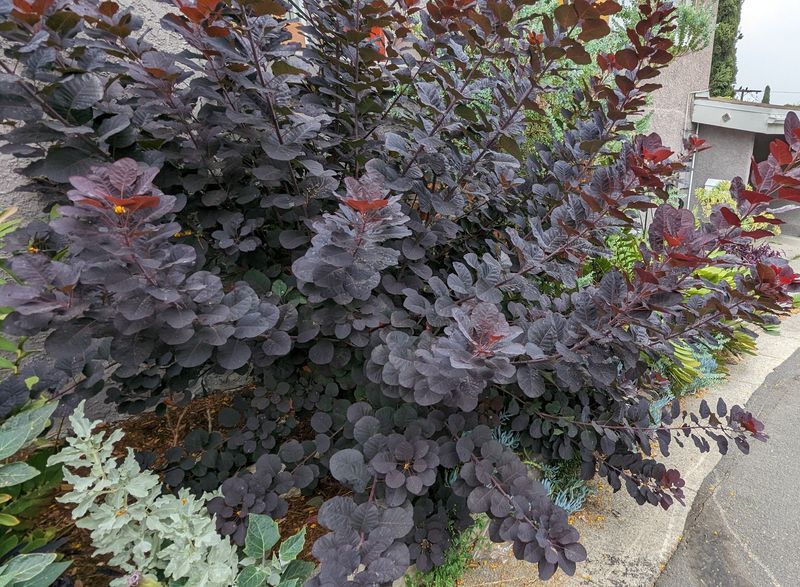
Despite the name, Smoke Trees are generally large shrubs and rarely grown as trees in the garden. Not all varieties of this plant have dark foliage, but cultivars such as 'Royal Purple' or 'Witchcraft Black' have deep purple leaves that will become very dark in late summer before fading to red in Autumn before the leaves fall for Winter. Large groups of purple/pink seed heads form a smoke-like appearance in early summer creating the dramatic effect that they are named for. This plant should be used as an accent plant in sunny location.
Cotinus coggygria is hardy to USDA zones 5-9. Some sources will indicate that it is hardy to zone 4 but this is only for the green-leaved varieties.
Agonis flexuosa 'After Dark'
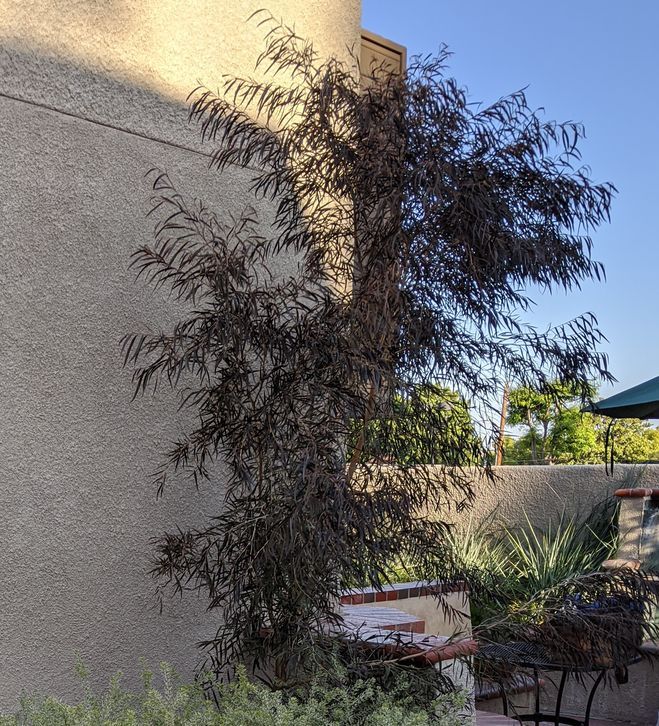
Agonis Flexuosa is a wonderful drought tolerant tree with leaves that smell minty when crushed, giving rise to the common name "Peppermint Tree". The straight species has green leaves but several varieties are available with purple leaves such as 'After Dark' or 'Burgundy'. Unlike other trees on this list, this is an evergreen plant whose leaves stay the same color year round, so this is a better choice if you want a dark leaved tree year-round. Although it can grow up to 25ft (7.5m) tall, it is a slow grower and is a good choice as a patio tree, or even grown in a container. The canopy can be quite wispy, so this is a good tree for creating a filtered sun effect on a patio.
Agonis flexuosa is hardy to USDA zones 9-11. Agonis does not tolerate shade and it must be planted in a sunny location.
Phormium tenax 'Platt's Black'
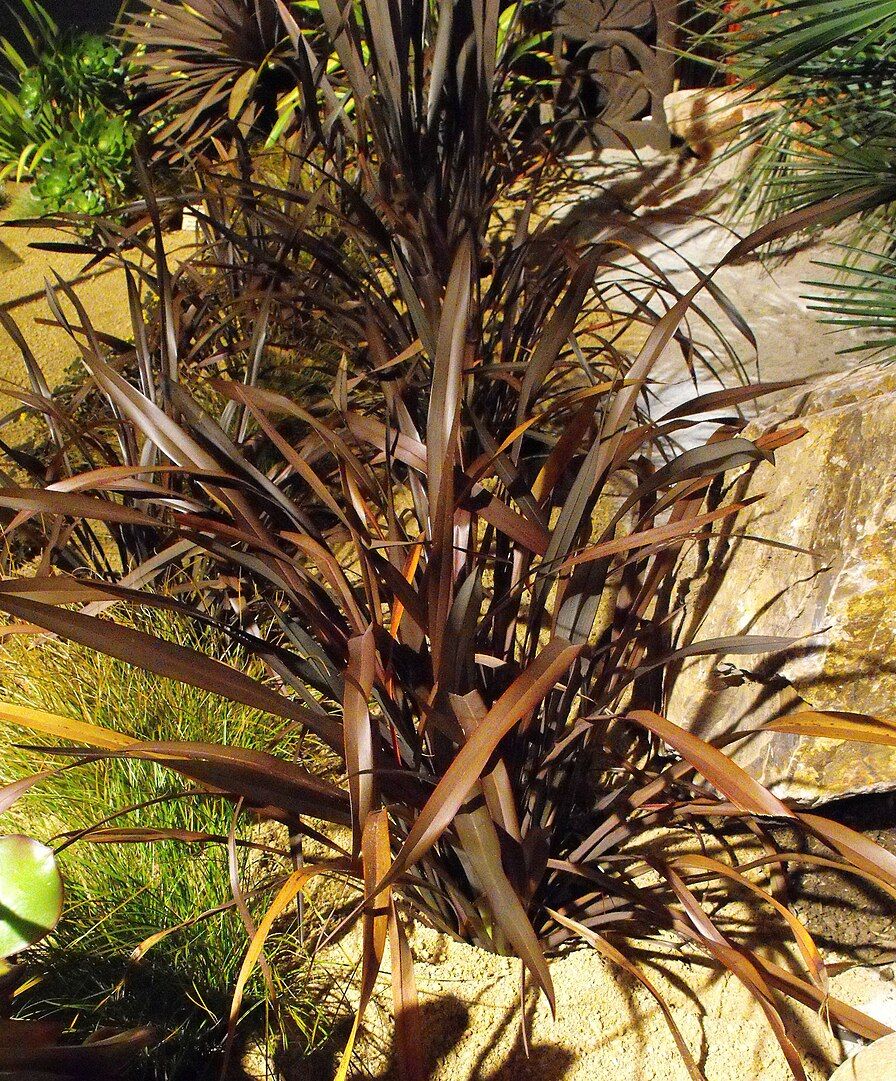
Phormium 'Platt's Black' is a very dark leaved cultivar of New Zealand Flax. This looks great either as a specimen plant, or mixed in with lighter coloured plants with a similar "grass-like" foliage. 'Platt's Black' is one of a number of dark versions of this plant but this is the darkest version I have experience with. This is an evergreen plant that retains the same color of dark foliage year round. Phormium tenax typically grows to around 4-6ft (1.2-1.8m), requires very little maintenance and is fairly drought tolerant. This plant works well in contemporary or Mediterranean gardens.
Phormium tenax is hardy to USDA zones 8-11.
This is a small taste of the world of dark colored plants and limited to plants I have worked with. If you have any stunning dark plants you'd like to share, please let us know.




